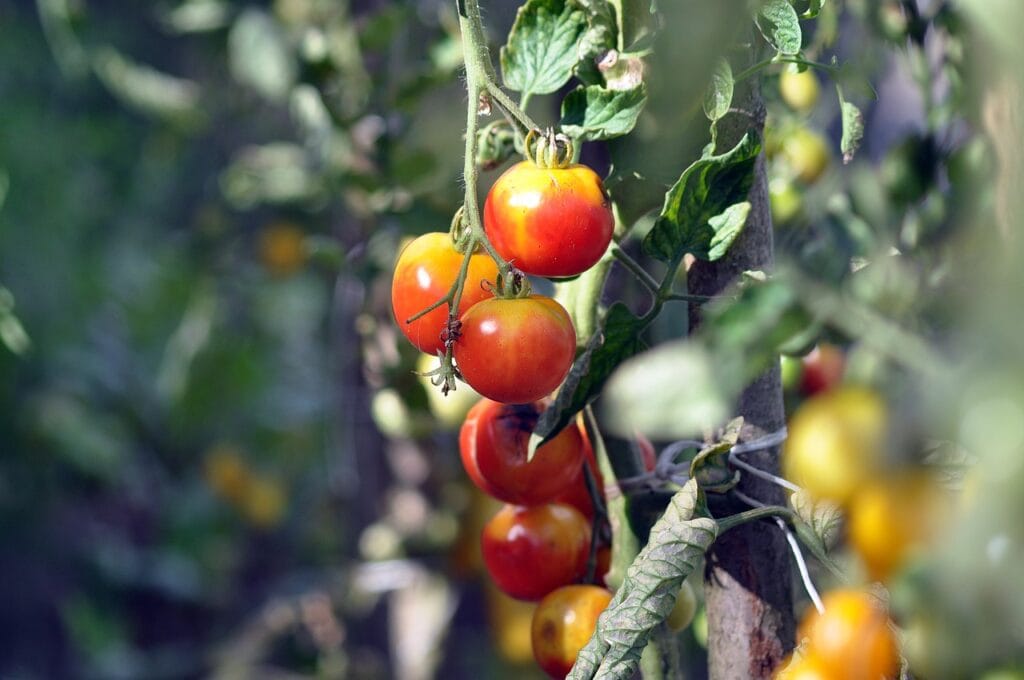How to Keep Birds From Eating Your Tomatoes: 7 Humane Ways
-
Pete Ortiz
- Last updated:

Tomatoes are popular vegetables in most gardens. They are fresh, healthy, very tasty, and easy to grow. However, there are common problems that gardeners face when growing tomatoes. From pests that can strip your plants bare of their leaves overnight to diseases like septoria leaf spot, tomato growing concerns may seem endless. One of the most permeating problems on tomatoes is birds.
There is nothing quite as disheartening as pouring your blood, sweat, and tears into your garden, only to find that birds have haphazardly been munching on your prized tomatoes. Birds simply love tomatoes as much as humans do. They often raid gardens and bite on all the tomatoes, whether ripe or unripe, leaving you with nibbled-on tomatoes that are worthless. Over 20 different bird species are known to make a meal from a tomato. The species include blue jay, woodpeckers, mockingbirds, robin, and thrush.
Fortunately, you can protect your tomato plants from birds. In this article, we will look at the different methods to protect tomato plants from birds. You can combine some of these methods to offer more protection for your prized tomato plants.
Read on to learn more.
How to Tell if Birds Are Eating Your Tomatoes
Before we look at the intricacies of protecting your tomatoes from birds, we first have to determine whether it’s birds damaging your plants or other rodents. Often, birds use their beaks to tear the skin of tomatoes to get into the fleshy parts of the fruit. This is usually different from how rodents feed on the fruit. Rodents chew on the tomato and leave bite marks behind.
Here are a few signs that birds are destroying tomatoes in your backyard:
1. Presence of Holes in Tomatoes
As earlier mentioned, birds use their sharp beaks to break the skin of tomatoes to access the fleshy, nutritious parts inside. Most of the fruit will look intact, but once you turn it on the side, it will look like there are a bunch of holes in it.
In the more delicate cherry tomato variety, the nibbled fruits will likely be on the ground. Since birds cannot wolf down a whole tomato, small puncture marks on tomatoes are the number one indicator that birds are eating your tomatoes.
2. Bird Droppings in Immediate Surroundings
Like most animals, birds also leave their excrement near where they feed. Since birds like to perch near their feeding grounds, chances are high that you will find bird droppings near your eaten tomatoes.

 The 7 Humane Ways of Deterring Birds from Eating Your Tomatoes
The 7 Humane Ways of Deterring Birds from Eating Your Tomatoes
Physical Barriers
1. Bird Netting
Bird nets are considered some of the most practical physical barriers that you can use against bird invasion in your garden. They limit the bird’s ability to fly in and access an area where your tomatoes are growing.
For nets to achieve this deterrent function, you may have to build a framework that will hold the net in place on top of your tomato plants. You could opt to purchase fence posts or simply make wooden stakes and place them around the patch to hold the netting into position.
Also, ensure that you secure the net to the ground with a string or wire. Once the netting and framework are tightly secured, birds will not be able to land in your garden and feast on your tomatoes.
2. Caging the Tomato Plant

Over the years, most gardeners have been caging their plants to protect them from different types of pests. The same concept can be used in tomato plants as well. Cages are especially suitable for protecting the shorter, shrubbier tomato varieties. These cages usually support the growth of the tomato plant by allowing it to grow in an upright position while preventing it from growing wild and spreading throughout your lawn. Not only that but cages also protect the tomato plant from sunscald and other diseases when properly done.
Caging tomato plants will also protect your prized tomatoes from birds. The bars on the cage will create a barrier, thus preventing birds from reaching the tomatoes. Moreover, the cages allow the plant to grow bushy and contained, hiding the ripe tomatoes from birds. However, this method will only prevent large avian species from feasting on your tomatoes.
Some cages usually have gaps that are large enough for one to fit their hands through when harvesting. Unfortunately, this also means that small birds will sneak through.
3. Cloches
Cloches, just like cages, are common barriers used against birds. However, they’re more versatile in their application compared to nets and cages. For starters, cloches protect tomatoes against weathering elements, more specifically, excessive heat and wind. They also help protect plants from pesky rodents and insects, thus preventing the spread of diseases. Cloches can also be used as barriers between tomatoes and birds.
Similar to bird netting, the cloches can also be wrapped around a tomato plant or pre-installed bird cages to act as a barrier against birds. Alternatively, you can create your own cloches, giving you maximum protection against anything that may seek to harm your tomato plants. There are two types of cloches:
Plastic Bottle Cloches
Plastic Bottle cloches usually protect saplings and seeds against predators and cold environmental conditions. Plastic bottles are suitable because they are transparent enough to let sunlight through but limits aeration. As such, plastic cloches should only be used sparingly, especially in areas that experience high temperatures. Once your tomato plant has outgrown the cloche, you have to remove it to avoid destroying the plant altogether.
Wire Cloches
You can also DIY your cloche using rabbit wire, which usually has two pieces. The first bit creates a cylindrical shape around the tomato plant, while the second bit covers the top of the cylinder. Depending on the size of your plant, you can adjust the cloche to accommodate the growth of the plant while preventing birds from accessing the tomatoes.
Distraction Tactics
Even after painstakingly creating physical barriers but birds still find a way to access your tomato plants, you might want to distract them by baiting them. In this situation, food and water would work great as a distraction from your tomato plants.
4. Give Them Water

One of the main reasons that birds are attracted to tomatoes is because their juicy and fleshy parts offer a reprieve from thirst. This is usually the case during the hot summer months when water is scarce. So, placing some water sources in your yard will distract the birds away from your prized vegetable garden. Just make sure that the water source is in a shaded area and there is plenty of it for the birds to drink and bath in.
5. Offer Alternative Food Sources
Ripe tomatoes not only help quench the thirst of most birds but also provide a source of sustenance and nourishment. Sometimes, birds invade vegetable gardens because they are not getting enough food in the wild. This could be because of the presence of a predator, or simply because they don’t have anything to feed on after food crops have been harvested. Either way, you can lure the birds away from your tomatoes by installing a bird feeder.
Scare Tactics
Sometimes, a bird may be too persistent that no matter how much you try to distract it or how much you limit their access, they still find a way into your tomato garden. In such a case, you may have to take more drastic measures such as purposely scaring them away from your plants.
Birds may be majestic and graceful creatures, but they get scared very easily. There are many ways that you can scare birds away from your garden. Some are simple and you can DIY at home, while others are more expensive and require considerable investment. You can choose one depending on your needs, preferences, budget, or the scale of bird invasion in your garden.
6. Scarecrows

This is perhaps the oldest scare tactic that has been used for hundreds of years to chase away birds in fields and farms all over the world. The concept behind scarecrows is quite simple: you just have to fool the bird into thinking that a human is standing guard against a garden at all times.
With some rags and a couple of sticks, you can make a human-like structure that will scare away even the most obstinate of bird species.
7. Hanging Objects
As earlier mentioned, birds are very squeamish animals. This is a defense mechanism that has developed over the years because they are pretty low in the food chain. So, sometimes the slight movement of hanging objects is enough to scare away the birds from accessing your vegetable garden. Flashy objects, reflectors, and wind chimes would all invoke the desired effect in birds.
- Wind Chimes: A single wind chime may not be scary to birds. However, if a number of them are hung next to your vegetable patch, they will produce a cacophony of noise that will discourage birds from going near your tomatoes. Simply position several wind chimes in strategic locations around your vegetable garden for optimum results.
- Flashy Objects: We all tend to notice when flashy objects pass by our vicinity. The same concept applies to birds. They are scared by shiny, fast-moving objects. To create such a visual effect, tie a few DVDs and CDs to a pole and let them sway in the wind. When the surface of the CDs catches the sun, they flash out varying colors, which warn the birds from flying to the veggie patch. You can also use Christmas ornaments to achieve a shiny visual effect.
- Reflectors: The reflectors installed in bicycles and vehicles can also scare birds away from your yard. You can hang them next to your tomatoes, and the light reflected from their surface will scare away most bird species. Since moving reflectors are more effective at reflecting light, you should consider tying them on a string and letting them dangle from the roof.
- Balloons: You can also deter birds from your yard by tying up balloons. They are a cheap and effective method especially if they are positioned in a way that allows movement. So next time some birds start nibbling on your tomatoes, simply inflate a couple of balloons and hang them on posts around your garden. However, despite being a cheap bird deterrent alternative, it is not long-lasting. So, you might want to combine this method with other deterrent tactics for better results.
Conclusion
As mentioned above, protecting your tomatoes from pests and insects is fairly easy. It is not an exact science that involves a lot of processes. Some preventative methods may work on some bird species but won’t work on others, especially the smaller variety. Try different methods until you find one that suits your needs and situation.
See Also:
Featured Image Credit: artellliii72, Pixabay
Contents


